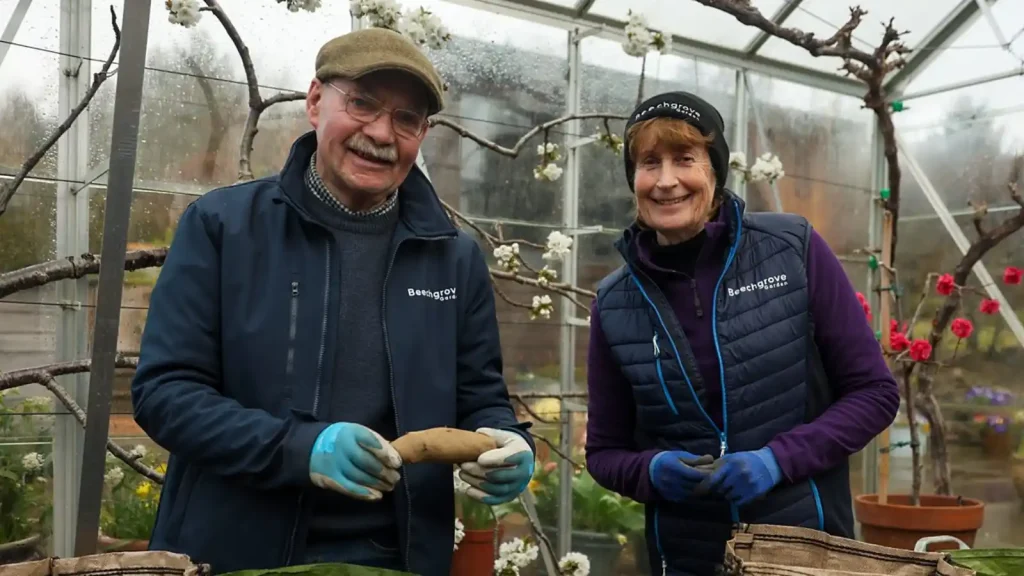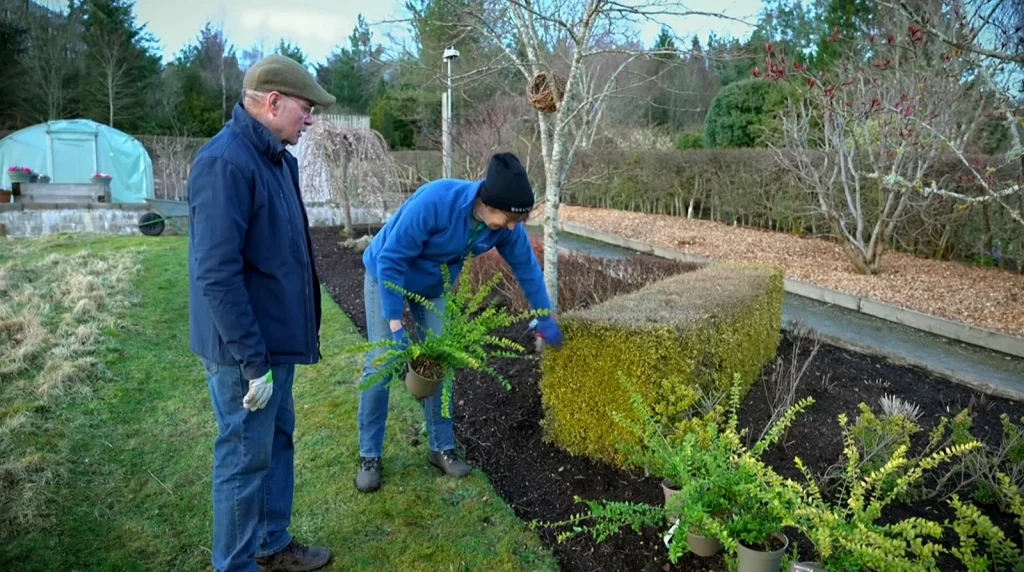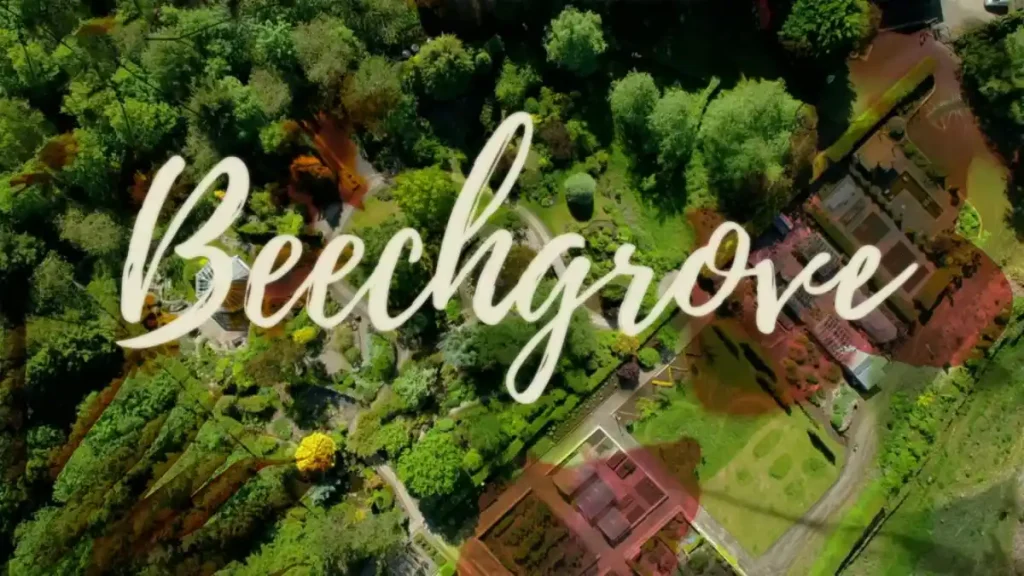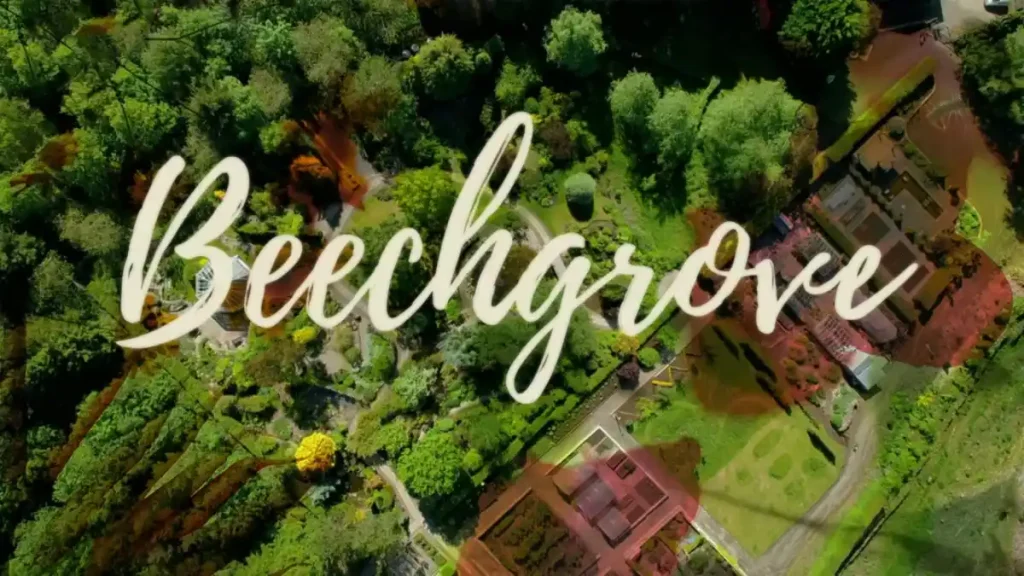The Beechgrove Garden 2024 episode 2 – In the verdant expanses of Beechgrove, George Anderson and Carole Baxter embark on a timely agricultural endeavor, planting an array of blight-resistant potato varieties. Situated just outside the bustling city of Aberdeen, this segment of their garden becomes a focal point for innovation and sustainability, addressing common challenges faced by potato growers.
As the season ushers in vibrant spring colors, the show takes viewers on a detailed exploration of the myriad daffodil varieties and classifications that are available to enthusiasts. Carole and George delve into the unique characteristics of these flowers, providing invaluable insights for gardeners looking to enhance their floral displays. From the striking vibrancy of the petals to the distinct fragrances, each variety of daffodil brings its own charm and appeal, contributing to the biodiversity of any garden.
In another part of the garden, George takes on the task of sowing broad beans, a staple in many kitchens for their nutritional value and versatility. This activity not only highlights the practical aspects of gardening but also emphasizes the connection between the garden and the table, encouraging viewers to consider the journey of food from soil to plate.
Meanwhile, Calum Clunie makes a much-anticipated return to the show with the first of his updates from his exceptionally productive allotment in Leven. Calum’s segments have become a highlight for many viewers, offering a glimpse into the rewards of dedication and hard work in the realm of allotment gardening. His practical tips and firsthand experiences serve as a source of inspiration and guidance for both novice and seasoned gardeners alike.
The second episode of “The Beechgrove Garden 2024” is a testament to the show’s commitment to providing diverse and engaging content for its audience. By integrating topics such as blight resistance in potatoes, the beauty and variety of daffodils, the cultivation of broad beans, and the personal triumphs of allotment gardening, the episode offers a comprehensive look at the joys and challenges of gardening. Through expert advice, practical demonstrations, and a passion for the natural world, “The Beechgrove Garden” continues to be a beacon of knowledge and inspiration for gardeners across the nation.
The Beechgrove Garden 2024 episode 2
Winning the Battle Against Potato Blight: Expert Strategies and Insights
Potato blight, particularly known as late blight, is a formidable adversary in the garden, leading to the decay of both foliage and tubers under warm, wet conditions. This pathogen, which spares neither potatoes nor tomatoes, represents a significant challenge for gardeners and commercial growers alike. Understanding the nature of this disease and implementing effective control measures can significantly mitigate its impact, preserving the health of your crops and ensuring bountiful harvests.
Understanding Potato Blight
What is Potato Blight?
Potato blight or late blight, caused by the organism Phytophthora infestans, is a disease characterized by rapid deterioration of the plant’s tissues, leading to collapse and decay. This condition, affecting potatoes and tomatoes, becomes prevalent in climates that favor its spread, especially during warm, wet weather. It’s critical to distinguish late blight from early blight, another condition affecting potatoes, to apply appropriate management strategies.
Symptoms of Potato Blight
The symptoms of late blight are unmistakable and devastating:
- Rapidly spreading, watery rot of leaves, leading to collapse and brown discoloration.
- Brown lesions on stems.
- Tubers showing a reddish-brown decay beneath the skin, which can develop into a soft rot, exacerbated by bacterial invasion.
Strategies for Controlling Potato Blight
Non-Chemical Control Measures
Implementing non-chemical strategies can significantly reduce the incidence and severity of potato blight:
- Deep Burial or Burning of Infected Material: To prevent the spread, infected plant material should be buried deeply or burned.
- Early Harvesting and Use of Resistant Cultivars: Cultivars with known resistance, such as Athlete, Alouette, Carolus, and the Sarpo varieties, should be prioritized.
- Improving Soil Management and Rotation: A rotation system of at least four years, combined with avoiding planting susceptible crops in the same soil, can reduce disease prevalence.
Chemical Control
As of the latest guidance, there are no fungicides available to gardeners specifically for the control of potato blight. Thus, the emphasis remains on cultural and physical control methods.
Understanding the Biology of Blight
Potato blight thrives under specific environmental conditions, requiring prolonged surface wetness for infection. The pathogen is capable of producing spores that can be wind-blown across long distances, making early detection and control challenging. Recent research into the pathogen’s genetic variations suggests the potential for more resilient strains, necessitating continuous vigilance and adaptation of control strategies.
Potato blight remains a significant threat to potato and tomato crops, demanding vigilant management and the application of both traditional and innovative control methods. By understanding the nature of the disease, recognizing its symptoms early, and applying effective prevention and control strategies, gardeners can protect their crops and enjoy the fruits of their labor. Embracing resistant varieties, practicing good garden hygiene, and staying informed about the latest developments in disease management are key steps in the ongoing battle against potato blight.
Ultimate Guide to Growing Potatoes: From Planting to Harvest
Discover the joy and satisfaction of growing your own potatoes with our comprehensive guide. Whether you’re cultivating earthy new potatoes, floury bakers, or the perfect roasters, potatoes are a versatile and beloved staple in diets worldwide. The beauty of potato gardening is its simplicity and accessibility; you don’t need a sprawling garden as potatoes thrive just as well in containers on a patio or balcony.
Types of Potatoes to Grow
First Earlies
Often referred to as ‘new’ potatoes, first earlies are the quickest to harvest, ready in June and July. Their short storage life means they are best enjoyed fresh from the garden.
Second Earlies
Maturing a few weeks after the first earlies, second earlies are harvested in July and August. Like the first earlies, they are best consumed soon after harvest.
Maincrop Potatoes
The maincrop varieties take the longest to mature and can be harvested from August to October. These are the potatoes of choice for baking, roasting, and mashing, offering the advantage of longer storage times.
Planting Your Potatoes
Before planting, it’s crucial to ‘chit’ your potatoes. This process involves allowing the seed potatoes to develop shoots, which can lead to a more abundant harvest. Place them in a cool, light spot until shoots are 1-2cm long. When it’s time to plant:
- Prepare the Soil: For optimal growth, enrich your soil with well-rotted organic matter in an open, sunny site.
- Planting Depth and Spacing: Plant seed potatoes 12cm deep and 30cm apart in trenches, with 60cm between rows. For container planting, cover them with compost and continue to add more as they grow.
- Earthing Up: As shoots emerge, mound soil around the bases to protect from sunlight and promote healthy tuber development.
Caring for Your Potato Plants
Regular watering, especially during dry periods, and keeping the area weed-free are essential for healthy growth. Earthing up, or piling soil around the growing stems, prevents the tubers from turning green and becoming inedible.
Harvesting and Storing Potatoes
Harvesting
- First Earlies: Harvest in June and July when the plants are still flowering.
- Second Earlies: Harvest in July and August, similar to first earlies.
- Maincrop: Harvest from August to October, when the foliage has yellowed and died back.
Storing
Store maincrop potatoes in a cool, frost-free place. Use hessian or thick brown-paper sacks to exclude light, checking regularly for any signs of rot.
Troubleshooting Common Problems
- Slugs: These pests can be a nuisance, particularly under moist conditions.
- Potato Blight: This fungal disease can be mitigated by growing resistant varieties or cutting down plants at the first sign of infection.
Growing your own potatoes is a rewarding experience that yields delicious results. Whether you’re a seasoned gardener or a novice, the versatile potato offers something for everyone. Start with choosing the right variety, follow through with care and attention during the growing season, and enjoy the fruits of your labor from harvest to table.
F.A.Q. The Beechgrove Garden 2024 episode 2
Q.: What is potato blight?
A.: Potato blight, also known as late blight, is a plant disease caused by the organism Phytophthora infestans, characterized by rapid deterioration of the plant’s tissues, leading to collapse and decay. It affects both potatoes and tomatoes, particularly in warm, wet climates.
Q.: What are the symptoms of potato blight?
A.: The symptoms of potato blight include rapidly spreading, watery rot of leaves, leading to collapse and brown discoloration, as well as brown lesions on stems. Tubers may also exhibit reddish-brown decay beneath the skin, which can develop into a soft rot.
Q.: How can potato blight be controlled?
A.: Potato blight can be controlled through various measures:
Non-chemical methods include deep burial or burning of infected material, early harvesting, and planting resistant cultivars.
Chemical control is limited, but cultural and physical methods such as improving soil management and rotation can help mitigate its impact.
Q.: What are the types of potatoes to grow?
A.: There are three main types of potatoes to grow:
First Earlies, harvested quickly and best consumed fresh.
Second Earlies, harvested slightly later than first earlies.
Maincrop potatoes, harvested later and suitable for baking, roasting, and mashing.
Q.: How can I grow potatoes successfully?
A.: To grow potatoes successfully:
Prepare the soil by enriching it with organic matter in a sunny site.
Plant seed potatoes at the appropriate depth and spacing in trenches or containers.
Care for your potato plants by watering regularly, keeping the area weed-free, and earthing up to protect tubers.
Harvest potatoes at the right time and store them in a cool, frost-free place to prevent rot.




